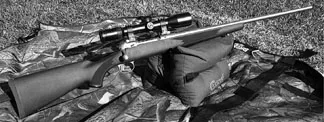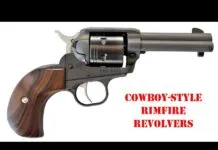
According to Winchester, the main values of its Short Magnum (WSM) cartridges are that when compared to conventional, long-action calibers, the 270 WSM, 7mm WSM and 300 WSM exceed the ballistics of the 270 Win., 7mm Rem. Mag. and 300 Win. Mag. respectively. Also, WSM rifles achieve these improved ballistics in short-action configurations which purportedly are lighter and faster handling than their long-action counterparts.
We’ve tested several of the fat-but-fast WSM and WSSM cartridges over the years, usually comparing them to their closest standard-action competitor. As you might expect, sometimes we liked the WSM/WSSM guns better than standard chamberings, and sometimes we didn’t.
This time around we wanted to set aside the multiple-cartridge matchups and put three similar 270 Winchester Short Magnums to the test. Toward that end, we acquired three rifles, each measuring about 43 inches in length and weighing about 7 pounds. Our test subjects were the Savage Arms 16FSS No. 17425, $569; a Browning A-Bolt II Composite Stalker No. 035012248, $734; and the Ruger KM77RFP MK II No. 17839, $695.
How We Tested
The Savage Arms and Browning rifles arrived with adjustable triggers. To level the playing field for comparison to the Ruger, we elected to test with the trigger resistance on each rifle set as delivered. To collect [PDFCAP(1)], we visited the 100-yard range at American Shooting Centers located in George Bush Park on the western edge of Houston (www.amshootcenters.com). Our bench setup consisted of a Caldwell Tack Driver bag to support the forend and a Protektor rabbit ears bag beneath the buttstock. Our targets were Birchwood Casey’s orange-colored 3-inch circle Target Spots with a 0.7-inch diamond in the center mounted on white paper. We combined our sighting-in process with a break-in regimen firing 130-grain soft-point Federal Power-Shok ammunition. We used a Nikon Titanium 5.5-16.5X 44mm scope at full power to produce five shot groups with the 130-grain rounds plus two other rounds topped with 150-grain bullets. They were the new Federal Fusion rounds and Winchester’s Power Point ammunition. Each rifle was tested over a two-day period from the 100 yard bench. Light conditions remained partly cloudy throughout.
According to our Dwyer wind meter, ($16.96 from www.sinclairintl.com), wind speeds varied from 5 to 11 mph for much of our tests, but we were forced to wait out a blow that calmed to average gusts of about 15 mph on the days we tested the Ruger rifle.
Once data was collected at 100 yards, our seventh session was spent firing from alternate shooting positions to evaluate the flexibility of each rifle.
In this portion of our test, we shot with a Zeiss Diavari 1.5-6X42mm T,DM/V scope (www.zeiss.com/sports). We chose the number 8 reticle because it offered fine cross hairs at the center surrounded by heavier lines that would speed target acquisition. Here’s what we found:
[PDFCAP(2)]
Viewed in silhouette, all three of our rifles looked about the same. But the Savage Arms 16FSS was fit with the manufacturer’s AccuTrigger that added a lever to the face of the trigger. One passerby at the range remarked that it looked like a Glock. Indeed, the center portion of the trigger did provide an extra level of safety. This lightly sprung lever, trademarked the AccuRelease, must be completely depressed to unblock the sear and allow the rifle to fire. This trigger system was designed to be adjustable by the owner to offer resistance ranging from 1.5 to 6.0 pounds. Adjusting the trigger required removing the stock. We found removing the two bolts surrounding the trigger guard and a third beneath the fore end to be a simple task. A special tool was supplied to set resistance. We measured the trigger pull as delivered to be 3 pounds, which felt perfectly comfortable to our trigger fingers. This weight of pull was about half the weight of our other rifles. It didn’t necessarily feel like a two-stage trigger but our impression was that engaging the AccuRelease safety lever served to dial in the shooter mentally in preparation for each shot.
The Savage Arms 16FSS is also referred to as one of ten Weather Warrior rifles on the www.savagearms.comwebsite. The 16FSS is available in as many as nine calibers, with our 270 WSM model about two-thirds the way up the power chart. Capacity in this caliber was 2+1. Free floating and fashioned with button rifling, the barrel’s rate of twist was 1 in 11 inches. The internal magazine was fully enclosed and accessible only from the top. Our other two rifles offered a hinged floor plate for additional access. The stock was neutral in terms of added contours and offered checkering at the pistol grip and on the forend. Despite the rubber butt pad being sloppily applied, we thought the stock was well suited to this rifle. None of our shooters complained about alignment, grip or lack of index. All three of our rifles had sling-swivel studs mounted front and rear. There was quite a bit of flex in the forend, especially at the tip, where we were able to fit eight dollar bills. The top of the stainless receiver was drilled and tapped for scope mounts, and the 16FSS came with a set of two-piece mounts already in place.
The bolt offered two lugs and was removable by depressing the cocking indicator and the trigger simultaneously. We found this process to be clumsy compared to the method of release found on our other rifles The cocking indicator was located on the right hand side of the receiver just behind the ejection port. We felt that the change in position meant to indicate a cocked action was too subtle to be of use. Also, we don’t like to touch the trigger for any reason other than to fire the gun. The three-position safety was located directly behind the bolt and easily accessible to the thumb. The central position held the trigger locked, but the bolt was free to move. But again, we didn’t think the difference between positions was distinct enough to be trusted. We chose to operate the safety in only the full on and full off positions.
At the range we learned that 270 WSM is a hard-kicking cartridge. Each of our test rounds chronographed at velocities in excess of 3100 fps when fired from the Savage Arms rifle. In fact, the average muzzle energy produced by the Winchester Power Point ammunition in our model 16FSS rifle was the highest overall in our tests, (3375 ft-lbs.). With temperatures approaching 80 degrees, we were in shirt sleeves and did not benefit from any level of protection from recoil that heavy clothing would have provided. We resorted to wearing a PAST Mag-Plus recoil shield. We were able to single feed each round without having to press them down into the magazine, but avoided this method for fear of introducing undue wear to the extractor. There were no malfunctions in feeding throughout our tests.
Accuracy was rewarding. We were able to print an average size group of 1.0 inches firing the Federal Power Shok ammunition and also achieve our tightest group overall firing the Federal Fusion ammunition, measuring about 0.8 inches. The Winchester 150-grain Power Point rounds brought us a single 1.0 inch group, but in total group size averaged out to a respectable 1.3 inches. However, when firing the Winchester rounds we had a great deal of difficulty raising the bolt. We could not detect any obvious case expansion, so we think that the case was locking down against the ejector upon ignition. This is not unheard of when firing heavier magnum loads, but it gave us pause to reconsider choosing a rifle chambered for short magnum rather than standard .270 Winchester ammunition. To minimize this problem in our rapid action test, we decided to stay with the 130-grain Federal ammunition, which fortunately was not only the most accurate round in the 16FSS but also the least expensive of our test rounds.
Firing standing unsupported, we found that most shooters preferred to lower the stock about 3 inches or brace it with the armpit before working the bolt. The bolt handle needed to be hit smartly upward with an open palm before being racked in each direction. But in our view, the list of negatives was short. The Savage Arms 16FSS was not only the least expensive rifle but the only one in our tests that shot at least one MOA group with each variety of test ammunition.
[PDFCAP(3)]
There are nineteen different A-Bolt rifles listed on the www.browning.comwebsite and the A-Bolt II Composite Stalker is one of the newer guns. This rifle is available in 18 different calibers plus fourteen other models augmented with the BOSS shooting system. Our rifle came without the Ballistic Optimizing Shooting System, and thanks to its blued barrel and action, our most expensive test rifle was also the most visually understated. The only accents on the Browning A-Bolt II Stalker were the trigger and the bolt, which included a cocking indicator. Stainless steel might be more weather resistant than the finish on this rifle but we think most hunters will appreciate less reflected light. The polymer stock was checkered both at the pistol grip and along the fore end. The gap at the tip of the fore end showed about seven widths of a dollar bill between the stock and the free float barrel. But we noticed that the fore end was shorter and more rigid than the stock found on the Savage Arms rifle. Contributing to this was the fact that the barrel, (offering a 1 in 10-inch twist), continued at full width for about 1.75 inches forward of the action before tapering. The rubber butt pad was expertly contoured and fit to the stock. Capacity was 3+1 rounds. The magazine was a box design attached to the hinged floor plate unlocked by a button located high in front of the trigger guard. An empty magazine can be removed from the floorplate and replaced with a loaded one. The magazine can also be stripped down for inspection or rebuilt as necessary. The receiver was drilled and tapped for a scope mount. None was supplied but the holes were plugged with headless screws. The two position safety, (on/off), was located directly behind the bolt and atop the grip that swept downward clear of the bolt’s movement. Detent on the safety was heavy and sure. Whenever the gun was cocked a stainless steel indicator slid out from beneath the bolt. Its presence was both visually obvious and since it was placed directly in front of the trigger safety it was readily accessible to the thumb for a tactile indication. The bolt handle was capped with a round knob that was somewhat flattened and angled in a slight turn to the rear. This created a natural index of the bolt handle to the palm. We did not have to press the trigger to remove the bolt. The bolt stop was unobtrusively placed along the left side of the receiver shielded from incidental contact by a contour in the stock. Press and the bolt was released. The bolt offered increased contact area by offering three lugs instead of the more common two-lug design.
The Browning trigger can be adjusted to about 3.5 pounds by removing the trigger guard and turning a screw located behind the trigger. We measured the weight of the trigger pull on the Browning A-Bolt II rifle to about 5 pounds without any hint of grit or creep. We liked the pistol grip because it filled our hands evenly and enabled us to isolate the trigger finger for maximum control. At the range we found that the Browning would not stand for single round loading unless we first pressed each round fully into the magazine. Firing through our Oehler Chronograph, (www.oehler-research.com) we found that in terms of velocity our Browning was a little behind the Savage Arms rifle, about 57 fps on average for all shots fired. Groups fired with each of our 150 grain loads measured between 0.9 and 1.4 inches and we did not find it difficult to unlock the bolt after firing the Winchester 150 grain Power Point rounds. Perhaps the distribution of stress to three evenly spaced lugs was the answer to the problem experienced in the Savage Arms and Ruger rifles. This made cycling the action faster and more enjoyable. We felt that the angle of the bolt handle on the Browning rifle gave us better access to the bolt and helped us integrate the two separate movements of lifting the bolt and drawing it back after each shot. The result was that we had the least amount of difficulty maintaining our original mount when cycling the action of the Browning A-Bolt Composite Stalker.
[PDFCAP(4)]
Perhaps the most striking feature of our Ruger rifle was its stainless-steel finish in bold contrast to its flat black polymer stock. Listed as a member of the All-Weather family on the website, there are 18 different rifles in the MKII family.
Among the useful features on the gun was the hinged magazine floorplate latch that was mounted flush with the front of the trigger guard. Another was the use of integral scope rings that attach directly to the receiver supplied at no extra cost. Our rifle arrived with medium height Ruger S100R series rings. Additional rings are available in a range of heights, color and inner diameter from ruger-firearms.com for about $64. The barrel featured a 1-in-10-inch twist. The one-piece bolt with two lug surfaces also differed from our Browning and Savage Arms rifles. The bolt included a non-rotating, Mauser-type controlled-feed extractor and a fixed blade-type ejector. The bolt was easily removed by pulling the stop lever, which hinged outward from the left hand side of the receiver. The trigger, which was not operator adjustable, was controlled with a three-position safety. The safety lever had to be swung fully to the rear for ignition. Pushed fully forward the trigger was prevented from moving, as was the bolt from opening similar to our other rifles. The third, central position also neutralized the trigger but allowed for operating the bolt for the purpose of loading or unloading. The more familiar we became with this system the more we saw the value in it. The three positions were instantly recognizable but we could nevertheless envision some confusion in adding a second safety-on position.
The stock on our Ruger rifle was checkered at the pistol grip and at the fore end including the Ruger insignia front and rear. The contour of the stock above the pistol grip was much thinner than on our other test rifles and the top of the grip area was sculpted with a variety of angles. We liked the way it looked but some of our staff felt it was distracting and uncomfortable. The rubber butt pad was cleanly applied but as was the case with each of our lightweight magnum rifles we would have liked more protection from recoil than a simple rubber pad can offer. We might go so far as to change to a recoil reducing stock such as the CompStock by Knoxx Industries, (www.knoxx.com).
Comparing the data on our accuracy chart showed that the Ruger rifle finished third. We thought that part of the problem was that the thin pistol grip was making it difficult for our hand to settle to the task of releasing the trigger. Resistance was measured at 6 pounds. The trigger broke cleanly but still offered a hard feel to the shooter. Target model M77 MKII rifles are available with two-stage triggers, but not in caliber 270 WSM.
The Ruger also lagged in production of velocity and power. We did manage to shoot a single 1-inch five-shot group coupled with the Winchester Power Point ammunition but the accuracy chart does not tell the whole story. Before our groups opened up we managed to shoot a number of three-shot groups measuring approximately 0.8 inches. In fact nearly all our groups started out with at least two tight shots. One explanation that we think has merit would be heat. Each of our rifles were negatively affected by heat but since the Ruger rifle did not have a free floating barrel the reduction of surface area exposed to the air meant that the barrel heated up sooner and took more time to cool. In our field test that focused on repeat fire we noticed that the ball like knob on the bolt was harder on the palm and not as easy to reach despite length of pull being comparable to our other test guns. Also, we found our hand brushing up against the safety in the forward, (safety off), position as we pushed the bolt upwards. We could foresee the possibility of a gloved hand snagging on this lever.
Gun Tests Recommends
• Savage Arms 16FSS 270 WSM No. 17425, $569. Best Buy. The 16FSS delivered at least one MOA group with all three of our test rounds. Also, we liked the AccuTrigger, but the action binded slightly after firing the hottest loads.
• Browning A-Bolt II Composite Striker 270 WSM No. 035012248, $734. Buy It. The A-Bolt II favored the heaviest loads, which in our view was the reason we would buy a 270 WSM rather than a .270 Winchester rifle. Bolt operation remained smooth and fast, unaffected by pressure from our hottest test loads.
• Ruger KM77RFP MK II 270 WSM No. 17839, $695. Conditional Buy. The Ruger was a very handsome rifle, but some of our shooters would have preferred a wider-gripped stock, lighter trigger, and a safety that was tucked out of the way. Free-floating the barrel might improve accuracy simply by forestalling overheating.





























